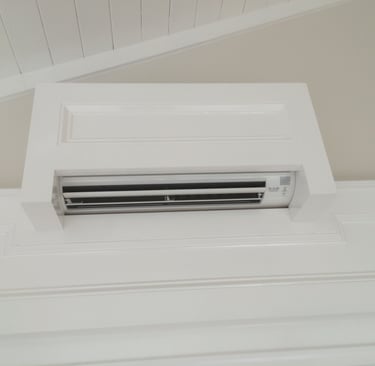The Difference Between a Mini-Split and a Split System Installation
The Difference Between a Mini-Split and a Split System Installation
HVAC
HVAC FRONT ROYAL
3/20/20242 min read


The Difference Between a Mini-Split and a Split System Installation
When it comes to cooling and heating your home, there are several options available. Two popular choices are mini-split systems and split systems. While they may sound similar, there are some key differences between the two. In this article, we will explore the differences between a mini-split and a split system installation.
What is a Mini-Split System?
A mini-split system, also known as a ductless system, is a compact and flexible cooling and heating solution. It consists of two main components: an outdoor compressor unit and one or more indoor air handlers. The outdoor unit is connected to the indoor units through a small conduit, which contains the refrigerant lines, power cables, and a condensate drain line.
One of the main advantages of a mini-split system is its flexibility. The indoor air handlers can be installed in different rooms or zones, allowing for individual temperature control. This means that you can cool or heat specific areas of your home without wasting energy on rooms that are not in use.
What is a Split System?
A split system, on the other hand, is a traditional central heating and cooling system that uses a network of ducts to distribute conditioned air throughout the home. It consists of an outdoor unit, which houses the compressor and condenser, and an indoor unit, which contains the evaporator coil and blower fan. The indoor unit is usually located in the basement, attic, or a dedicated utility closet.
Unlike a mini-split system, a split system requires ductwork to deliver conditioned air to different rooms. This means that the installation process can be more involved, especially if your home doesn't already have ductwork in place. However, once installed, a split system can provide efficient and consistent cooling and heating to your entire home.
The Main Differences
One of the main differences between a mini-split and a split system installation is the presence of ductwork. A mini-split system is ductless, which means that it doesn't require any ductwork. This makes it a great option for homes without existing ducts or for room additions where extending the ductwork may not be feasible.
Another difference is the level of control and flexibility. With a mini-split system, you have the ability to control the temperature in individual rooms or zones. This can help you save energy and increase comfort by only cooling or heating the areas that are being used. In contrast, a split system provides whole-home comfort but may not offer the same level of control over individual rooms.
Additionally, mini-split systems are typically more energy-efficient than split systems. The absence of ducts eliminates the energy losses associated with ductwork, resulting in higher efficiency and lower utility bills. However, it's worth noting that both types of systems can be energy-efficient if properly sized, installed, and maintained.
Conclusion
In summary, the main difference between a mini-split and a split system installation lies in the presence of ductwork and the level of control and flexibility. A mini-split system is ductless and offers individual temperature control, making it a great option for homes without ducts or for room additions. On the other hand, a split system provides whole-home comfort but may require ductwork installation. Both systems have their advantages and can provide efficient cooling and heating, so it's important to consider your specific needs and consult with a professional HVAC technician to determine the best option for your home.
HVAC FRONT ROYAL LLC
524 N ROYAL AVE
STE C,
Front Royal, VA 22630
+1 540-252-3230
info@hvacfrontroyal.com
